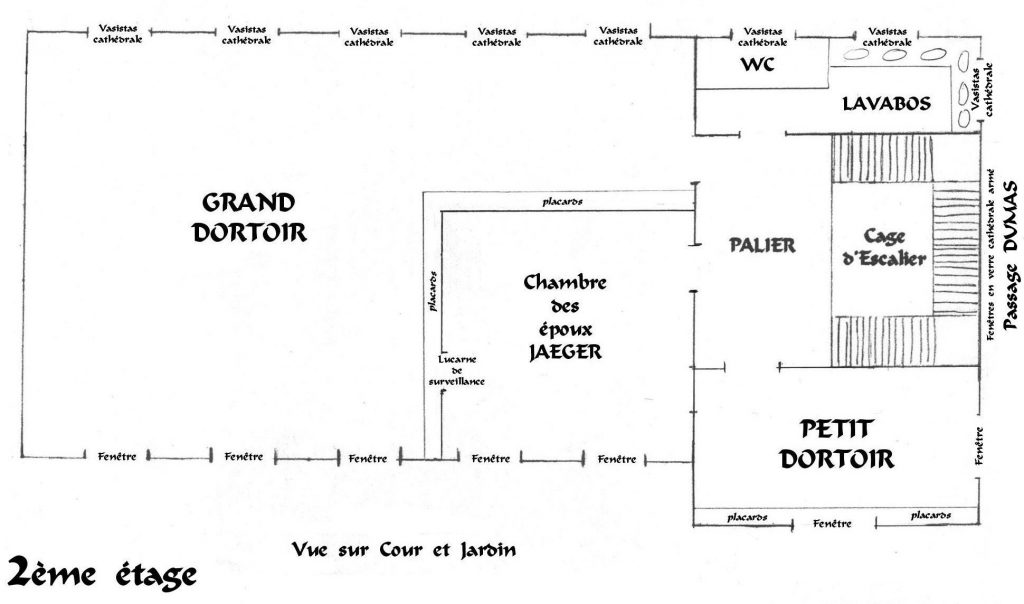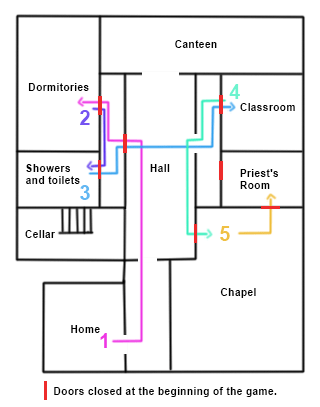
WHAT'S ORPHELINAT?
For a month, my team and I decided to design a project, where we had to deal with the subject of victims of history, or how to represent them in a video game.
We then turned to a horror game, telling the story
Some data :
5
People on the project
1
Month to make the project

Foreword :
When we were asked to rethink a historical episode from the point of view of the defeated, we first wanted to deal with the great battles of history. Then, through discussion, we quickly turned to battles that are little known or avoided by most people, such as the untouchable caste in India, child prostitution or the persecution of the Uyghurs.
But when we came to the subject of pedocriminality in the Church, we all agreed. We found it interesting that victims of abuse in orphanages are often also victims of the justice system. So, naturally, we wanted to make a horror game that would tell the story of the nightmare that these children have lived through and that would follow them throughout their adult lives.
Documentation :
In order to nourish our subject, we have been particularly interested in the cases of abuse carried out on children in Catholic orphanages around the years 50-60. The testimonies are numerous and it was not difficult to find resources to try to imagine what the life of a victim was like in this post-war era…
Synopsis :
It is a horror game in which you play as Adam, a post-war orphan who spent his childhood in a French Catholic orphanage in the 1950s.
Some twenty years later, you receive a letter from a forgotten old friend, Abel, in which you learn that he committed suicide because he could no longer bear the memories of his rape by the priest of the orphanage where you both grew up. Determined to prove Father Maxime’s guilt, you go to the place of your past….
The goal of the game will be to progress in the orphanage of his youth, to discover what happened to his lost friend, but also to himself.
LEVEL DESIGN
A - Documentation :
It was important for me to reference real buildings to get a kind of realism in the place.
So I did some research, either for plans like below.


Source : https://www.ajpn.org/sauvetage-Orphelinat-Bon-Secours-352.html
Or even photos.

I was also inspired by the orphanage of the series: The Queen’s Gambit who allowed to have several angles of the building through the scenes!
B - Prototyping :
I. Plan :
The plan has a certain symmetry to avoid the player getting lost, and to have a central place (the hall) that will be quiet and where nothing scary will happen.

I imagined the path that the player will have to follow according to what could be a typical day spent in this Catholic orphanage.
Thus, once the welcome is over, the plot goes like this:
- Dormitories → Waking up the children ;
- Showers → After waking up;
- Classroom → Classes begin;
- Chapel → Mass;
- Priest’s room → After Mass, the main place in which Father Maxime carried out his crimes;
The cellar and the upper floor are two places that are impossible to reach in the game phase, the first because of a securely locked door, the second because of a cave-in.
II. Blockout :
Now that the plan is validated by the team, we have to see if it works, and for that nothing better than to make a blockout to get an idea of the dimensions of the rooms and the walkthrough.
When the proportions seemed to be correct, and the layout of the rooms also, we could attack the artistic part and obtain a much more realistic level.
III. Lighting:
The sound and visual atmosphere will have an extremely important impact, especially for a horror game. I then worked on the lighting and post-processing to get a result that suited us!
This part was important to realize before all the staging, because we wanted to get something very dark. We had to be sure of our parameters before doing anything else, otherwise retouching would have been necessary but complicated on a deadline of 1 month.
C - Creation :
I’m going to detail the different steps of the level design, whether it’s the objectives of each room, as well as the cinematics that I made.
I. Home :
The welcome is a tutorial, he will be able to use all the mechanics of the game (open the door, and zoom on an object to interact with it).
Walkthrough :
Find class photo → Cinematic (Monster laughs → Monster appears → Monster flees) → Dorms unlocked.
II. Dormitories :
For this room, our intention was above all to introduce the real antagonist of our story, without making him appear without reason.
This is why we chose the dormitories. At first, the crying Adam hears guides him to the room and then stops when he arrives. They are only heard again when Adam goes to the bed. They stop for good once the creature appears in the hallway.
These cries are those of the children victims of Father Maxime’s abuse. The latter used to make his nightly rounds and so as not to attract his attention, the children of the orphanage held back their tears when they heard him coming.
Walkthrough :
Crying is heard → Arrival at the dormitory door → Crying is silenced → Find the stuffed animal → Flashbacks → Find the bed → Adam sits on it → Crying is heard louder → Antagonist appears → Crying is silenced → Player is paralyzed → Monster passes through the hallway → Player can move again → Bathroom unlocked.
III. Bathroom :
After the monster appears in the hallway, we want the player to be on guard as he walks in the direction of the monster. Will he jump on it?
The tension will then rise again when he has to open the bathroom door and Abel in his demonic form comes out.
Walkthrough :
Entering the bathroom → Opening the toilet door → Abel pops up and runs away laughing → Finding engravings → Class unlocked.
IV. Classroom :
The first flashback is directly related to the room. By making Adam’s memories almost tangible, he can relive the course as it was at the time. This gives the player the feeling that he is getting closer and closer to the truth, breaking the frame of memory to get closer to reality. The flashbacks evolve, they don’t only occur thanks to tactile stimuli (like with the teddy bear) or auditory stimuli (like with the crying), they are also visual.
An even more obvious clue to the identity of the first monster. Between his passivity, the sequence in the bathroom with the engraving of the initials of the two friends and finally, the fact that he is in Abel’s place in the classroom, the player should normally have understood that this shapeless creature is Abel. This will only be confirmed by the game at the end of the game.
Walkthrough :
Watch Abel → Interact with desk → Adam sits down → Cinematic → Flashback of class →Message appears on board → Chapel bell rings → Chapel unlocked.
V. Chapel :
The room that will make the tension and uneasiness grow. Through the flashback of the altar, the player will understand that there is something disturbing with Father Maxime (which he will have already seen through the photos and the painting).
Walkthrough :
Entering the chapel → Search for the altar with the bible → Fixed flashback of the mass → Return to reality → The priest’s room is unlocked.
VI. Priest's Room - The horror of the truth :
For Father Maxime’s room, we wanted, at first, a place that contradicts the idea of trauma.
Thus, a sequence will be triggered when the player enters the room. Adam will sweep the room with his eyes, which will be transformed to appear dreamlike, almost beautiful. The player can then move around the room, making the memories more real than ever. Objects can be observed in the room but cannot be analyzed. Observation will be interrupted along the way, as if Adam does not want to look at the objects in the room. This will reflect the trauma of what makes up this place.
After a certain number of objects observed, a flashback will show Adam that Father Maxime has hidden a journal somewhere in the room.
Once the diary is found and read, the room will change dramatically to give way to a hellish vision. We hope to show all the horror and shock that Adam experienced when he read Father Maxime’s confessions and learned the truth about his repeated rapes over the years.
Thus, the reassuring play, which reflects the idea of trust that sexual abusers try to establish with their victims in order to carry out their atrocities, is transformed into hell, transcribing the reality of the acts that were carried out.
Walkthrough :
Arrival in the room → Normal → Eye sweep → Dream room → Door behind Adam disappears → Player searches the room → After 3 or 4 objects analyzed → Flashback of Maxime hiding his diary → Finding the diary → Flashbacks → Infernal vision room → Second door leading to the corridor opens.
VII. The corridor of horror :
The cinematic continues, and the rhythm becomes more and more accentuated. The pressure will be at its maximum. He will have to watch, helplessly, the red eyes of the priest coming forward the source of all the trauma of his character.
The priest is here to punish the child who broke into the Father’s room. That’s why Adam doesn’t die, he loses consciousness and wakes up in the cellar of the orphanage.
The end of the game.